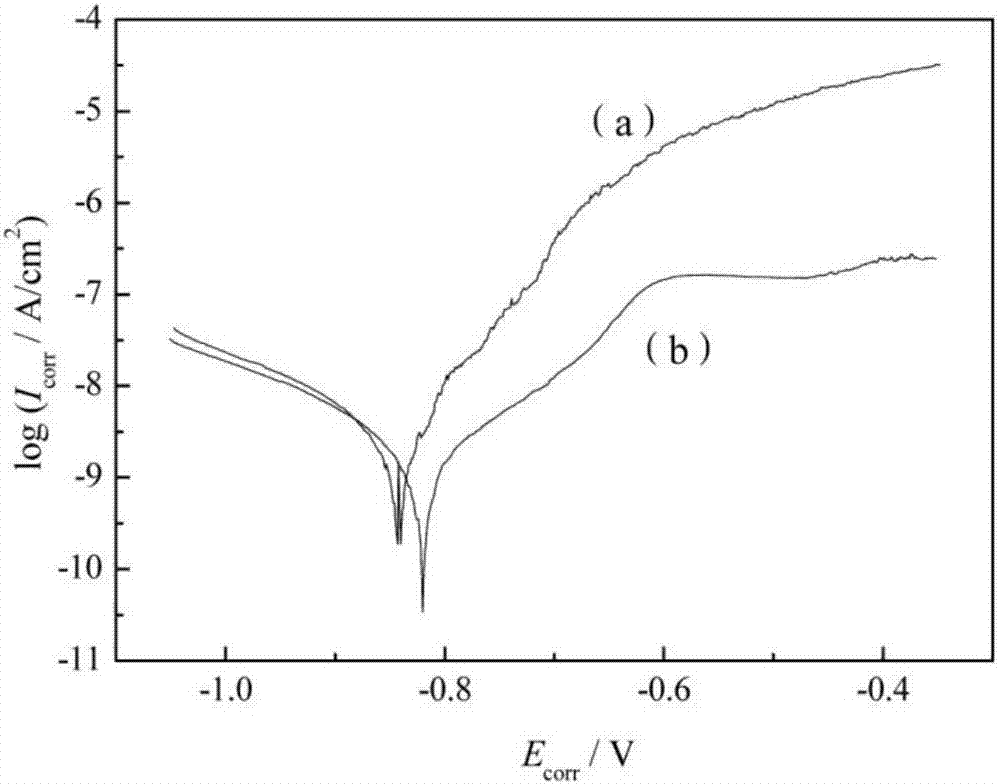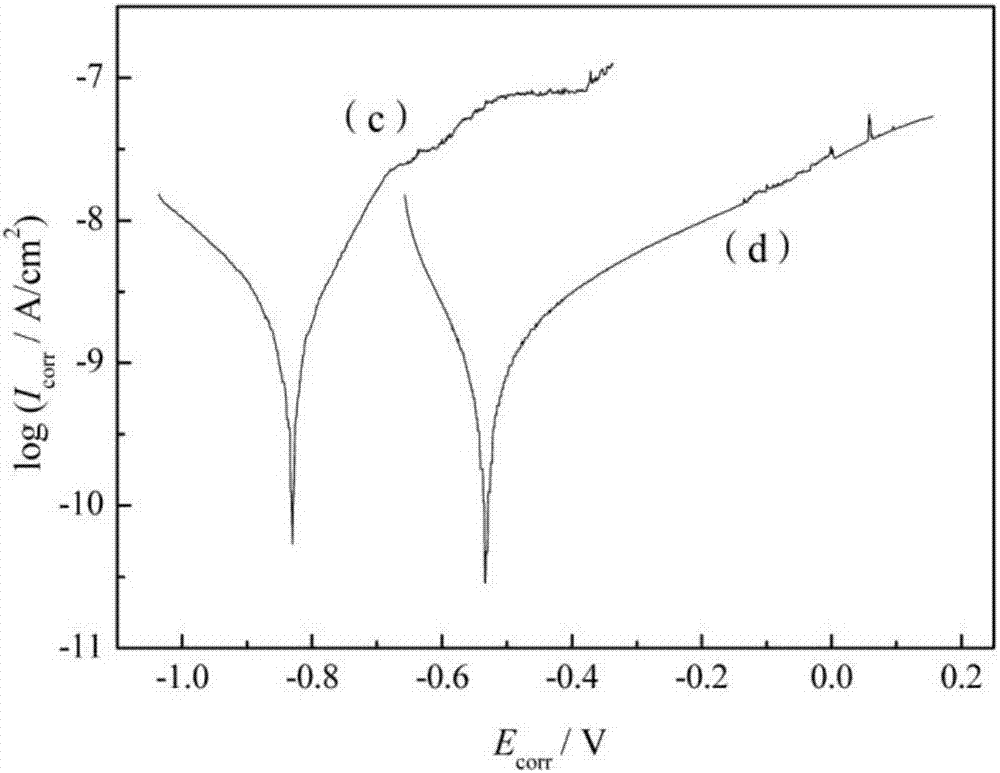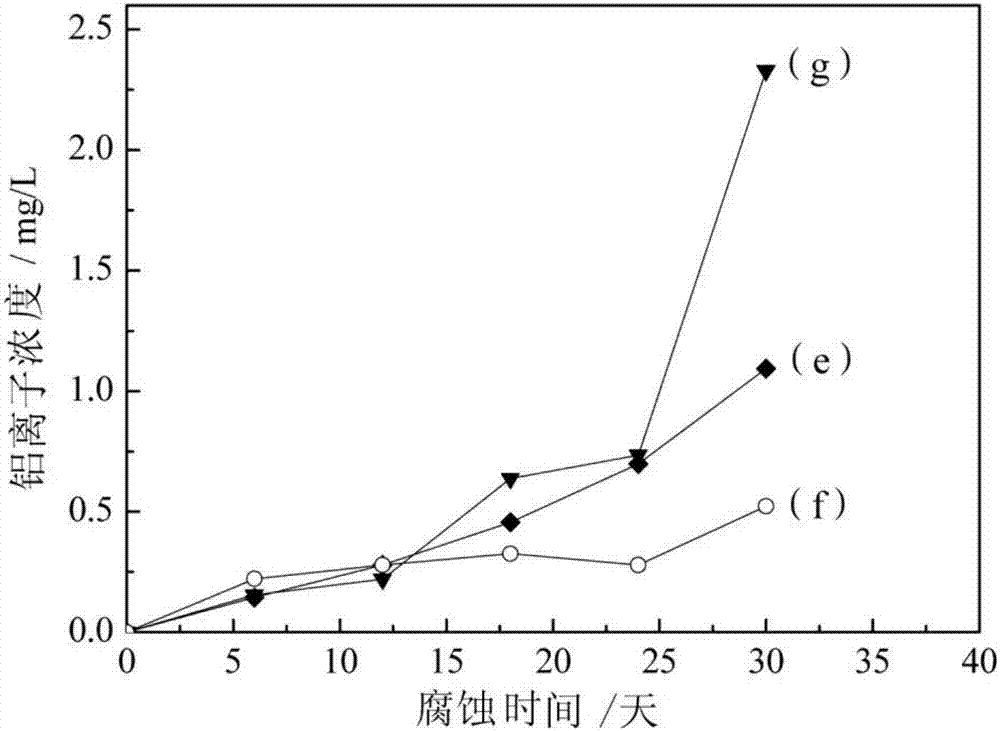Treatment method for improving corrosion resistance of surface of aluminum alloy
A technology of aluminum alloy surface and treatment method, which is applied in the direction of surface reaction electrolytic coating, electrolytic coating, anodic oxidation, etc., can solve problems affecting corrosion resistance, etc., and achieve easy control of the program, improvement of corrosion resistance, and simple sealing process Effect
- Summary
- Abstract
- Description
- Claims
- Application Information
AI Technical Summary
Problems solved by technology
Method used
Image
Examples
Embodiment 1
[0025] The aluminum alloy treated in this example is a commonly used antirust aluminum alloy Al5052, and the size of the sample is 50×25×5 mm. The concrete steps of this embodiment are:
[0026] (1) Surface treatment: Grind with 400#, 600#, 1000# sandpaper in sequence, and decontaminate and degrease the aluminum alloy specimen with distilled water, absolute ethanol, and acetone successively, and air-dry at room temperature for later use;
[0027](2) Micro-arc oxidation electrolyte preparation: 6g sodium silicate, 1g sodium tripolyphosphate, 1g sodium hydroxide, 1g sodium tungstate, 1g disodium edetate, 1g sodium metavanadate, mix and add 1L Distilled water is prepared as an electrolyte;
[0028] (3) Micro-arc oxidation treatment: the aluminum alloy sample in step (1) is used as anode, the stainless steel electrolytic cell is used as negative electrode, and the electrolytic solution prepared by step (2) is mechanically stirred in the electrolytic cell, and the stirrer rotating...
Embodiment 2
[0031] The aluminum alloy treated in this example is a commonly used antirust aluminum alloy Al5052, and the size of the sample is 50×25×5 mm. The concrete steps of this embodiment are:
[0032] (1) Surface treatment: Grind with 400#, 600#, 1000# sandpaper in sequence, and decontaminate and degrease the aluminum alloy specimen with distilled water, absolute ethanol, and acetone successively, and air-dry at room temperature for later use;
[0033] (2) Micro-arc oxidation electrolyte preparation: sodium silicate 10g, sodium tripolyphosphate 3g, sodium hydroxide 2g, sodium tungstate 2g, edetate disodium 2g, sodium metavanadate 1g, mix and add 1L Prepare electrolytic solution in distilled water;
[0034] (3) Micro-arc oxidation treatment: the aluminum alloy sample in step (1) is used as the anode, the stainless steel electrolytic cell is used as the negative electrode, and the electrolytic solution prepared by step (2) is used in the electrolytic cell, and mechanical stirring is ...
Embodiment 3
[0037] The aluminum alloy treated in this example is a commonly used antirust aluminum alloy Al5052, and the size of the sample is 50×25×5 mm. The concrete steps of this embodiment are:
[0038] (1) Surface treatment: Grind with 400#, 600#, 1000# sandpaper in sequence, and decontaminate and degrease the aluminum alloy specimen with distilled water, absolute ethanol, and acetone successively, and air-dry at room temperature for later use;
[0039] (2) Micro-arc oxidation electrolyte preparation: sodium silicate 10g, sodium tripolyphosphate 5g, sodium hydroxide 2g, sodium tungstate 3g, edetate disodium 2g, sodium metavanadate 1g, mix and add 1L Prepare electrolytic solution in distilled water;
[0040] (3) Micro-arc oxidation treatment: the aluminum alloy sample in step (1) is used as the anode, the stainless steel electrolytic cell is used as the negative electrode, and the electrolytic solution prepared by step (2) is used in the electrolytic cell, and mechanical stirring is ...
PUM
| Property | Measurement | Unit |
|---|---|---|
| thickness | aaaaa | aaaaa |
| thickness | aaaaa | aaaaa |
| thickness | aaaaa | aaaaa |
Abstract
Description
Claims
Application Information
 Login to View More
Login to View More - R&D
- Intellectual Property
- Life Sciences
- Materials
- Tech Scout
- Unparalleled Data Quality
- Higher Quality Content
- 60% Fewer Hallucinations
Browse by: Latest US Patents, China's latest patents, Technical Efficacy Thesaurus, Application Domain, Technology Topic, Popular Technical Reports.
© 2025 PatSnap. All rights reserved.Legal|Privacy policy|Modern Slavery Act Transparency Statement|Sitemap|About US| Contact US: help@patsnap.com



